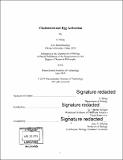| dc.contributor.advisor | Monty Krieger. | en_US |
| dc.contributor.author | Wang, Li | en_US |
| dc.contributor.other | Massachusetts Institute of Technology. Department of Biology. | en_US |
| dc.date.accessioned | 2019-11-04T20:20:28Z | |
| dc.date.available | 2019-11-04T20:20:28Z | |
| dc.date.copyright | 2019 | en_US |
| dc.date.issued | 2019 | en_US |
| dc.identifier.uri | https://hdl.handle.net/1721.1/122709 | |
| dc.description | Thesis: Ph. D., Massachusetts Institute of Technology, Department of Biology, 2019 | en_US |
| dc.description | Cataloged from PDF version of thesis. Page 236 blank. | en_US |
| dc.description | Includes bibliographical references. | en_US |
| dc.description.abstract | The high-density lipoprotein (HDL) receptor SR-BI controls the structure and fate of plasma HDL. The SR-BI knockout (KO) females are infertile, apparently due to their abnormal, cholesterol-enriched HDL particles. In this thesis, my colleagues and I examined the growth and meiotic progression of SR-BI KO oocytes and found that they underwent normal germinal vesicle breakdown; however, SR-BI KO eggs, which had accumulated excess cholesterol in vivo, spontaneously activated; they escaped metaphase II (MII) arrest and progressed to pronuclear, metaphase III and anaphase/telophase III stages. Eggs from fertile, wild-type mice were activated when loaded in vitro with excess cholesterol using a cholesterol/methyl-[beta]-cyclodextrin complex, phenocopying SR-BI KO oocytes. | en_US |
| dc.description.abstract | In vitro cholesterol loading of eggs induced elevation of intracellular calcium (the [Ca²⁺]i spike), reduction in MPF and MAPK activities, extrusion of a second polar body and progression to meiotic stages beyond MI. These results suggest the infertility of SR-BI KO females is due, at least in part, to excess cholesterol in eggs inducing premature activation, and that cholesterol can activate wild-type mouse eggs to escape from MII arrest. In the Chapter 3, I studied the detailed mechanism of egg activation induced by excess cholesterol. I showed that the [Ca²⁺]i spike induced by excess cholesterol was necessary for egg activation and also sufficient for further development of the egg to the blastocysts stage. Excess cholesterol, in calcium free medium, did not induce changes in [Ca²⁺]i, indicating that extracellular calcium was required for the [Ca²⁺]i spike and also suggesting the entry of extracellular calcium via plasma membrane channel(s). | en_US |
| dc.description.abstract | After screening of calcium channel inhibitors, single cell mRNA-sequencing and activation experiments using eggs from mutant females, I was able to show that co-inhibition of both the L-type calcium channel Ca[subscript v]1.3 and the transient receptor potential channel TRPC5, but not inhibition of either one alone, blocked the excess-cholesterol induced [Ca²⁺]i spike and egg activation. This result suggests that excess cholesterol activates the MII eggs by opening of Ca[subscript v]1.3 or TPRC5. Our results raise the possibility that excess cholesterol might also activate the same channels in other systems, and thus contribute to pathophysiology. | en_US |
| dc.description.statementofresponsibility | by Li Wang. | en_US |
| dc.format.extent | 236 pages | en_US |
| dc.language.iso | eng | en_US |
| dc.publisher | Massachusetts Institute of Technology | en_US |
| dc.rights | MIT theses are protected by copyright. They may be viewed, downloaded, or printed from this source but further reproduction or distribution in any format is prohibited without written permission. | en_US |
| dc.rights.uri | http://dspace.mit.edu/handle/1721.1/7582 | en_US |
| dc.subject | Biology. | en_US |
| dc.title | Cholesterol and egg activation | en_US |
| dc.type | Thesis | en_US |
| dc.description.degree | Ph. D. | en_US |
| dc.contributor.department | Massachusetts Institute of Technology. Department of Biology | en_US |
| dc.identifier.oclc | 1123217440 | en_US |
| dc.description.collection | Ph.D. Massachusetts Institute of Technology, Department of Biology | en_US |
| dspace.imported | 2019-11-04T20:20:27Z | en_US |
| mit.thesis.degree | Doctoral | en_US |
| mit.thesis.department | Bio | en_US |
